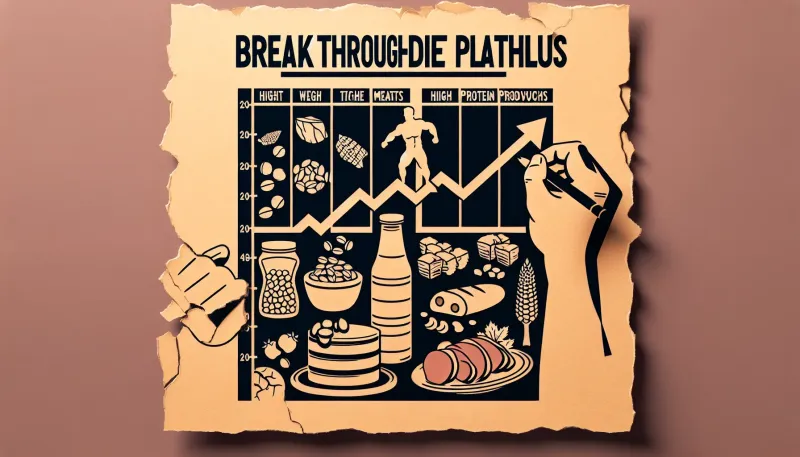Strategies for Plateau Busting with a High Protein Diet

Discover effective strategies for overcoming plateaus with a high protein diet. Learn how to modify your approach to maintain steady progress.
Hitting a plateau can be one of the most frustrating aspects of following a high protein diet. You may find yourself doing everything right and yet see no further progress. This article explores some effective strategies for overcoming plateaus and ensuring continuous progress on a high protein diet.
Understanding Diet Plateaus
Before diving into plateau-busting strategies, it's important to understand what a plateau is. Plateaus occur when your body adjusts to your diet and exercise routine, causing your progress (such as weight loss or muscle gain) to stagnate. It's a common occurrence that can be managed by making certain changes to your routine.
Strategies for Busting Plateaus
1. Vary Your Protein Sources
Consuming the same types of protein every day can lead to monotony and nutritional imbalances. By varying your protein sources, you can provide your body with a wider range of amino acids and nutrients essential for muscle growth and repair.
- Alternate between animal-based proteins such as chicken, fish, and lean beef.
- Incorporate plant-based proteins like beans, lentils, and tofu.
- Consider protein supplements if you're struggling to meet your protein goals.
2. Adjust Your Caloric Intake
When you hit a plateau, it’s often because your body has adapted to your current caloric intake. A slight adjustment, either an increase or decrease in calories, can help break through the plateau.
- For Weight Loss: Decreasing your caloric intake by 200-300 calories per day can help restart weight loss.
- For Muscle Gain: Increased caloric intake, particularly from lean proteins, can provide the extra energy needed for muscle growth.
3. Implement Intermittent Fasting
Intermittent fasting involves cycling between periods of fasting and eating. This strategy can help reset your metabolism and improve your body’s insulin sensitivity.
- Start with a 16:8 fasting method: Fast for 16 hours and eat during an 8-hour window.
- Ensure your eating windows focus on high-protein meals to maintain muscle mass and support weight loss.
4. Change Your Workout Routine
Mixing up your exercise routine can help force your body to adapt to new challenges, which can break a plateau. Incorporate a balance of strength training and cardio exercises for optimal results.
- Introduce new exercises or increase the intensity of your workouts.
- Alternate between high-intensity interval training (HIIT) and steady-state cardio sessions.
- Prioritize compound exercises that work multiple muscle groups at once.
5. Monitor and Adjust Macronutrient Ratios
While protein is crucial, the balance of carbohydrates and fats in your diet also plays a significant role in your overall progress. Tailoring your macronutrient ratios can help optimize your diet for your specific goals.
- For Weight Loss: Higher protein and lower carbohydrate intake can promote fat loss and preserve muscle.
- For Muscle Gain: A balanced intake of protein, carbohydrates, and healthy fats will support muscle growth and recovery.
6. Track Your Progress and Make Informed Adjustments
Consistently tracking your dietary intake and physical progress allows you to make data-driven decisions. Utilize apps or journals to monitor your meals, workouts, and body measurements.
- Review your progress regularly and adjust your diet or exercise routine as needed.
- Aim for gradual changes rather than drastic adjustments to prevent overwhelming your body.
7. Ensure Adequate Rest and Recovery
Recovery is a critical component of any successful fitness regimen. Your muscles need time to repair and grow, and your metabolism needs rest to function optimally.
- Aim for 7-9 hours of sleep per night to support overall health and recovery.
- Incorporate rest days and active recovery days into your workout schedule.
8. Stay Hydrated
Hydration is often overlooked but plays a crucial role in your diet and exercise performance. Proper hydration aids digestion, nutrient absorption, and muscle function.
- Drink at least 8-10 cups of water daily.
- Adjust water intake based on your activity level and climate.
Conclusion
Plateau busting on a high protein diet requires a multifaceted approach. By varying your protein sources, adjusting your caloric intake, incorporating intermittent fasting, varying your workout routine, monitoring macronutrient ratios, tracking progress, ensuring proper rest and hydration, you can break through plateaus and continue making progress. Remember, the key is to stay patient, make informed adjustments, and remain consistent with your efforts.



























